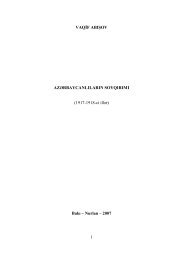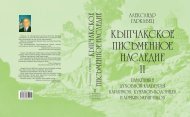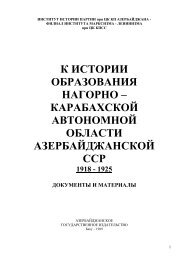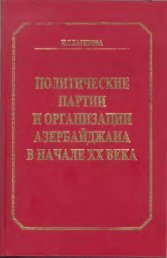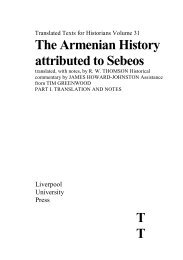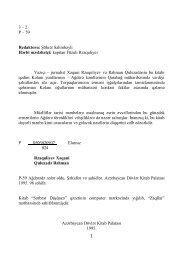ARMENIAN - Erevangala500
ARMENIAN - Erevangala500
ARMENIAN - Erevangala500
Create successful ePaper yourself
Turn your PDF publications into a flip-book with our unique Google optimized e-Paper software.
Seljuks, Mongol Invaders and Ottomans<br />
Emperor Romanus IV Diogenus (1068-71) was a skillful<br />
and circumspect general. He was left with the task of trying<br />
to cover the mistakes that the "Bulgar-slayer" and<br />
"Monomachus" Constantine had made in their frenzy of<br />
excessive expansionism . . . and he failed.<br />
The people living in the eastern part of the Byzantine<br />
Empire were tired o f endless taxation and loathsome religious<br />
pressure. They greeted the Turkish Seljuks as a<br />
lesser evil, if not as liberators.<br />
Near Mantzikert (Malazgirt), only a few hours march<br />
north of Lake Van, the deciding battle between Seljuks<br />
and Byzantines was fought. It ended in a total defeat for<br />
Romanus Diogenus, who was the first Byzantine emperor<br />
ever to be taken prisoner.<br />
The chivalrous victor, Alp Arslan, made a treaty with<br />
Romanus IV Diogenus, but as soon as he was back in<br />
Constantinople, the emperor met with a typical fate of the<br />
kind that have made Byzantine politics proverbial. The<br />
traitorous opposition burned his eyes out with hot irons,<br />
in spite of written quarantees that had been countersigned<br />
by the church.<br />
"It was only this monstrous postlude that turned the defeat<br />
of Mantzikert into a true catastrophe," writes Georg<br />
Ostrogorsky, because this made the treaty between Alp<br />
Arslan and the emperor Romanus IV null and void.<br />
The way was now open for the Turkish Seljuks. Just two<br />
years later, Konia (central Anatolia) was the capial of the<br />
Seljuk Empire of Rum. Armenian traders and craftsmen,<br />
known for their fine talents, were already following their<br />
new rulers - and enjoying an unprecedented religious and<br />
social freedom.<br />
Two generations later, the devestating Mongol invasion<br />
brought the blossoming Seljuk Empire of Rum to an<br />
abrupt end. In 1236, it was the Mongols who laid waste<br />
to flourishing Ani, not the Turkish Seljuks, who suffered<br />
just as much under the Mongol invasion as all the other<br />
peoples of eastern and central Anatolia. In an "official<br />
publication" of the "Catholicosate of Cili-tia", published<br />
in Lebanon, the following passage appears: "In 1065,<br />
when the Armenian kingdom fell simultaneously with the<br />
destruction o f its capital, Ani, by the Seljuks . . .". It is no<br />
wonder then that countless Armenians who read the publications<br />
of their churches in good faith do not know the<br />
truth about the fall o f the last semi-independent<br />
Armenian principalities in eastern Anatolia, which took<br />
place decades before the arrival o f the Seljuks.<br />
Photo at top: View o f the Ottoman fortress of Hoshap-Giizelsu,<br />
which served as a border fortification against the Persians in the<br />
East.<br />
25



